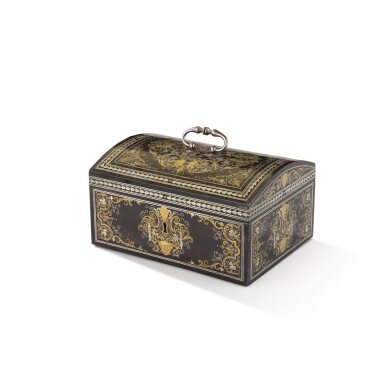Saint-Sulpice, l'écrin d'un collectionneur
Saint-Sulpice, l'écrin d'un collectionneur

A Louis XIV brass, pewter, ebony, tortoise-shell, wood and amaranth Boulle marquetred casket, circa 1700
Estimate
60,000 - 100,000 EUR
Lot Details
Description
decorated with grotesques and arabesques, the inside of the cover decorated with a panel of inlaid flowers and birds marquetry; with steel handles and fittings
Haut. 15 cm, larg. 28 cm, prof. 22 cm;
Height. 6 in, length. 11 in, depth. 8 1/2 in
Please note that this lot contains restricted materials. Sotheby's is not able to assist buyers with the shipment of any lots containing restricted materials into the US.A buyer's inability to export or import these lots cannot justify a delay in payment or a sale's cancellation.
Late collection Jean Pétin, Rue de Varenne, Paris
J. Wilhelm, C. Frégnac, Belles demeures de France, 16e - 19e siècle, Paris, 1977, p. 101.
Related literature
C. Demetrescu, Les ébénistes de la Couronne sous le règne de Louis XIV, Lausanne, 2021.
-A pair of caskets, one identical to ours, Paris sale, Palais Galliera, 22 December 1968, lot 89 (illustrated). This box had an almost identical marquetry on the inside of the lid, but with an imitation granite vase surrounded by flowers and birds. This pair of caskets later belonged to Jean Petin and then to the Paris trade, where they were exhibited at the 1994 Biennale des Antiquaires.
-A casket from the former William Beckford collection at Fonthill Abbey, Christie's London sale, 4 July 1996, lot 204, (on a brown tortoiseshell background).
-Two caskets, Couturier, Libert et Nicolaÿ sale, 22 October 1968, lot 89 (one with a brown tortoiseshell background, the other in ebony).
-Two caskets, Galerie Kugel, Paris, (one with a brown tortoiseshell background, the other in ebony).
-Two caskets, former Boniface de Castellane and Anna Gould collection, Christie's sale on 7 March 2017, lot 21a and 21B, (one with a brown tortoiseshell background, the other in ebony).
Boulle marquetry is sufficiently masterful and original in its designs to constitute an ensemble that has traditionally been attributed to André-Charles Boulle. However, the analysis of the motifs, the airy manner of the scrolls and sequences of brass foliate scrolls, the density of the pewter filigree, the variety of masks and grotesque profiles are not found in Boulle's compositions, where the marquetry is organized in a much more continuous fashion, often stemming from a gilded bronze ornament. Here, on the contrary, it is particularly compartmentalized. Our coffret is perfectly symmetrical, and the comparison with the above-mentioned coffrets is apt. A closer look at some of the inlaid panels of these chests reveals animals (eagles, lions, horses) on those from the Kugel gallery and the former Boni de Castellane collection, completing a composition that is tempting to compare stylistically with the four-leaf armoire in the Jones collection at the Victoria & Albert Museum (inv. 1882-1026) or the pedestal cabinet sold by Sotheby's in Monaco on December 3, 1994, lot 387.
The ornamental repertoire is directly influenced by Jean Bérain's plates, in particular the many highly expressive grotesque masks, used in profile at the end of scrolls or from the front, always grimacing.
As many curators and art historians have shown, Boulle was far from alone in producing this type of metal marquetry on a wood or tortoiseshell background in Paris at the end of the 18th century, a point made at length in C. Demetrescu's study of Crown cabinetmakers under Louis XIV. The production of certain cabinet-makers such as Oppenordt and the Poitou family, and more generally of certain Parisian workshops that had remained in the shadows, was sometimes fleshed out as a result of reattributions, which doctrine is now endeavouring to reconsider, thus contributing to the advancement of knowledge.
On the inside of the lid, our casket features a bois de rapport marquetry depicting a flowering vase with foliage scrolls and birds on the sides (which appears to be identical to the one adorning one of the caskets in the Kugel gallery). The marquetry is very delicate and of high quality, with areas where contrasts and optical effects have been accentuated by the use of hot sand. Here, too, we come close to the "paintings in wood" that André-Charles Boulle used to decorate some of his creations, such as the famous "armoire aux perroquets" or the casket in the J. Paul Getty Museum (inv. 84.DA.971), although we can't claim authorship.
You May Also Like










